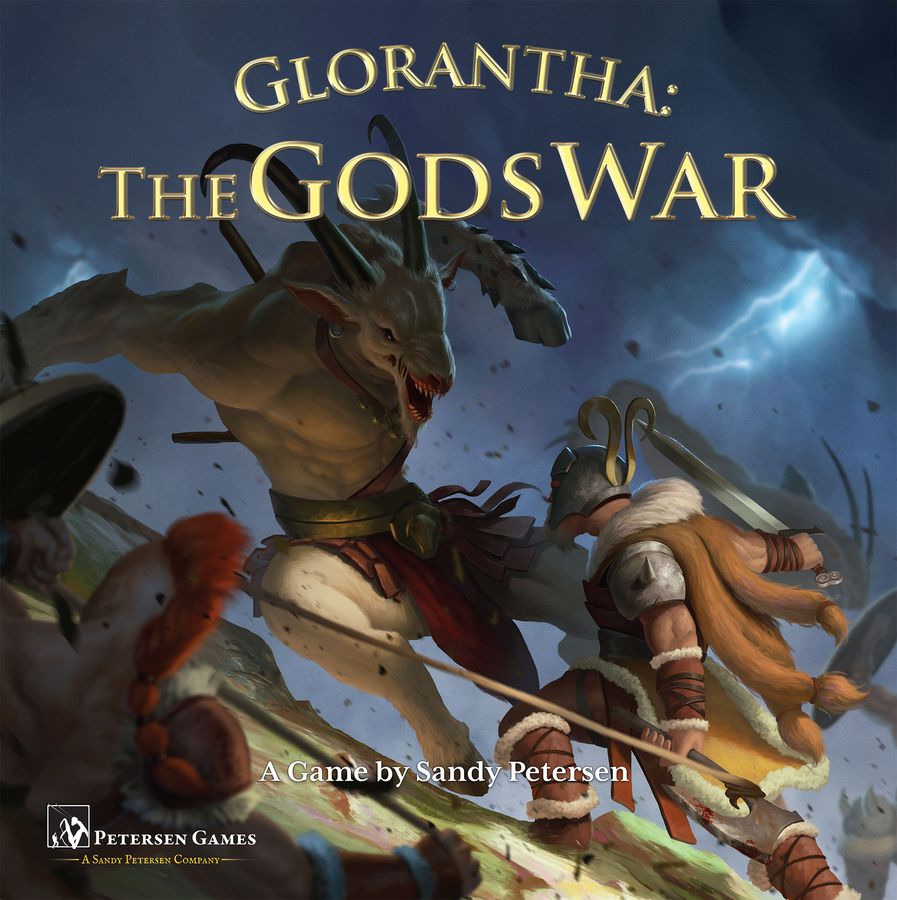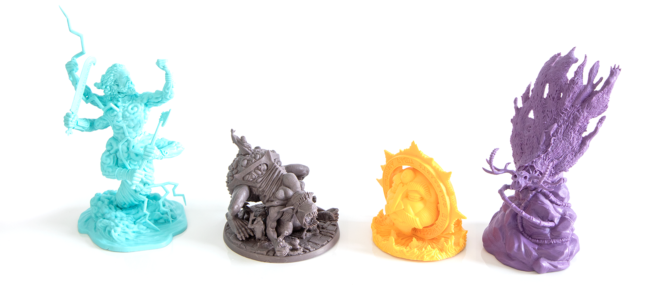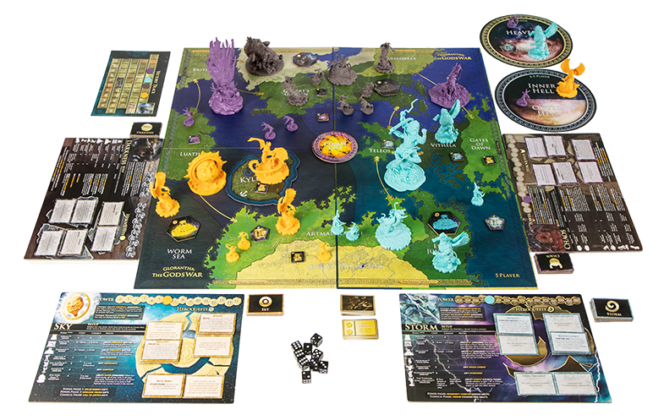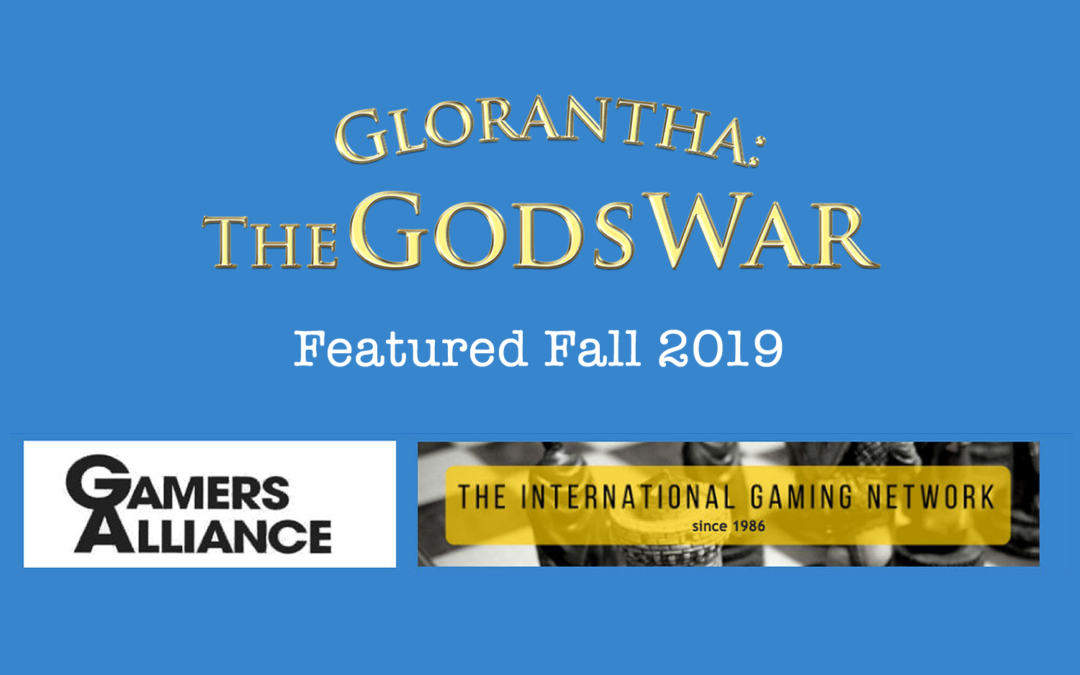Glorantha: The Gods War has been featured in the Fall 2019 issue of Gamers Alliance Report found on the Gamers Alliance web site.
Glorantha: The Gods War was launched on Kickstarter in August of 2016. Initially it was expected to be released in 2017. However, production delays resulted in it becoming a 2019 release. Petersen Games is probably best known as the publisher of Cthulhu Wars (2016) and for using very large game figurines. They are so big in The Gods War that I will resist calling them miniatures. My figurine of Orlanth, God of Storms is nearly 6” tall.
Without a doubt, The Gods War is massive. The game box measures 15.5” x 15.5” x 5.5” deep. It is heavy too. Once you start adding the expansions… well I now devote an entire bookshelf to storing the several boxes. Should you consider doing this? Let’s explore the reasons for and against.
Theme
Glorantha is a fictional world many role-players will recognize from the historic and popular Runequest system. At its peak, Runequest rivaled Dungeons & Dragons as a top tier role playing game. The myriad gods and unique magic system in Runequest made Glorantha a rich fantasy setting quite distinct from the mainstream elves-and-dwarves approach to fantasy. This setting proved very popular with roleplayers, and even spawned some strategy board games such as White Bear & Red Moon (Chaosium, 1975), Nomad Gods (Chaosium, 1977), and Dragon Pass (Chaosium, 1980 & Avalon Hill, 1983).
In Glorantha: The Gods War, the hex and counter approach used in those older games is set aside. The game now uses large areas on a massive map of Glorantha (30” x 30”). The core game provides very dissimilar factions devoted to four influential Gloranthan Gods: Storm, Sky, Darkness and Chaos. Each group receives several impressive plastic units for use on the map. These factions will battle on the map to establish dominance, vying to achieve 35 victory points first. Other materials include four detailed faction boards, a deck of “Rune” cards, several dice and lots of tiles. There is a lot to find in this massive box.
DUDES ON A MAP
No doubt about it, Glorantha: The Gods War is a dudes-on-a-map fighting game. The basic actions of any given turn revolve around four core actions: erecting buildings, summoning units, moving or fighting. Each turn a player can only conduct a single action. Initially players will often summon small “mortal” units or erect simple shrines. As they spread across the map, “heroes”, “lesser gods” and eventually “greater gods” enter the fray. Every unit is unique and there is no duplication from one faction to another. This makes learning how to play a little tricky as your units work differently than the ones you encounter. Fortunately, each faction board nicely outlines how that group plays. Each faction has unique abilities, starting positions, and varying in-game goals. This makes the selection of which faction to play a key decision.
Each faction will spend “power” to take actions. Power is derived from erecting different types of buildings. Most factions have three building types: shrines, temples and ziggurats. Factions can also gain power by showing progress on up to three “Heroquests”, which are pre-printed goals on each of the faction boards. Examples of using power include spending 1 power to summon a mortal minion, spending 1 power to erect a shrine (one building max per land), spending 2 power to summon a lesser god or spending 4 power to summon a greater god. Examples of the “Heroquest” goals include: “Have a minion, Hero, Lesser God and Greater God in play”; or “A Battle results in at least 2 Killed Units”. Perhaps even more important, progress on a Heroquest will give a gift – one of six enhanced abilities designed for each faction. These additional abilities can really change the flow of the game.
Often factions will get from 5 -10 power to use per game round. After a faction takes an action, the next clockwise (or sometimes counter-clockwise) faction acts. When your turn comes, you are obligated to act until you have expended all of your faction’s power.

After every faction has used all of their power, the game has two maintenance phases. First, a power phase awards power to the factions for the next round. After that, a Council Phase determines who will go first next round and victory points are awarded. Factions get VPs for every building on the map & for completed Heroquests (which have two halves to complete).
The MAP
The map is massive and has some interesting features. There are two off-board tile locations: The Sky Dome and Hell. Both the Sky Dome and Hell each have two playing areas. The entrance and exit to these areas are clearly marked on the map. Initially, the world has an area in the center of the map called the Spike. Each game, the Spike is doomed to shatter. Once any faction attains 10 VP the Spike shatters, opening the Chaos Rift. The Chaos faction works a bit differently with several of the core rules.
The massive plastic gods, lesser gods, heroes and mortal minions are most impressive. Everyone who has played on my copy of the game has been impressed by their stature. The details of the playing pieces are very nice. Each faction is a distinct color, making them clear that they belong to a certain faction.
There are tiles provided for the shrines, temples and ziggurats that each faction can build. I have never used them as I bought the buildings expansion. I suspect most players of the core game would strongly prefer the plastic buildings over the counters provided with the core game.
Several players have complained about the map quality in the core game. This reviewer is not bothered by it – it is functional and reasonably pleasant to view. It is a different map than the one shown on the Kickstarter campaign. I suggest checking photos if you might be concerned.

Overall, I find the core game production values strong. I would be disappointed if I had to use the building tiles. My recommendation is to spring for the buildings expansion.
GAMEPLAY
Let’s take a closer look at the four factions included in the core game:
STORM – Storm has somewhat basic mortal units but can give them very good movement abilities if he builds temples and ziggurats. Storm can swap two VPs to gain four power, a painful swap but potentially very effective. Storm has a lot of attack potential.
SKY – Sky starts with its greater god, Yelm, trapped in Hell. He will need to negotiate with another faction to get permission to leave Hell. On the bright side, Yelm can never die. Sky’s mortal minions are archers who can attack an adjacent area.
DARKNESS – Normally units must seek permission to leave Hell but Darkness may always leave Hell, entering anywhere on the surface world. And Darkness’s units may enter Hell from any temple or ziggurat Darkness builds. If Darkness can summon its greater god, all available trolls in the general pool can be summoned to Hell for free. Darkness loves Hell.
CHAOS – Chaos has no board presence at the start of the game. Chaos can cohabitate with other faction’s buildings, gaining extra power for each instance. Chaos uses its gifts and abilities to sap its foes strength. As the game goes on, Chaos tracks how many units are killed (helping this total mount, if possible) and should it summon its greater god, this total sets the strength of The Mad God, Ragnaglar.
The Gods War builds in a bit of narrative arc. Once the Spike shatters, all factions must struggle over the Chaos Rift. Once the Chaos Rift opens, the Chaos player enjoys a small advantage in some of the game play details and will fight to keep it open by potentially committing power that could otherwise be used in on-board movements and battles. However, the three rival factions are forced to join forces in order to battle the Chaos Rift but the amount of effort expended is up to each player. By neglecting this common effort, a faction will have more power for on-board activities. They will eventually close the Rift by committing buildings and units to the struggle but a weak effort may cause the Rift to endure longer. Once the Chaos Rift is closed, the center of the map changes once again with a new route to the Hell sideboard opening up. Another feature is a “floating island” on the seas of the world map. Units on this island can “sail” to adjacent seas during the game.
Another “baked-in” feature of the game is “The Great Compromise”. Once any faction attains 20 victory points, a new element of the game activates whereby players will participate in a phase where additional Victory Points will be awarded. This is handled in the Council Phase. At some considerable cost of power, a faction will hand out additional victory points to himself and opposing factions. The Great Compromise will basically cause the controlling faction to get 4VPs but then will award 3VPs, 2VPs and 1VP to each of the opposing factions. Normally the faction in last place will get the 3 VP, and the faction in third place will get 2VPs, leaving 1 VP for the final faction. Effectively, The Great Compromise serves as a catch-up mechanism and also ensures the game speeds along to the 35 VP end-game threshold.
EVALUATION & EXPANSIONS
In addition to the core game, this reviewer purchased the EMPIRES expansion (MSRP $139). EMPIRES brings four additional factions and additional game maps enabling games with as many as eight players. I have played the Gods War twice with a player count of five. I found the game was even richer with a fifth player. I have no experience with higher counts so I cannot say but suspect game duration might begin to extend with greater player counts. Even if you never played with more than four players, the utility of swapping in expansion factions is very appealing. It is possible to play The Gods War with any combination of factions desired.
Further expansions include Elder Races (MSRP $99). I am looking forward to playing with the warrior ducks! Further there is the Monsters expansion spread across three boxes of monsters (MSRP $39/each). I cannot comment on them as they are still waiting on my bookshelf.
I mentioned earlier that I have the Buildings expansion (MSRP $69). I view this expansion as a strong enhancement to the core game. It allows you to retire the building tiles and really elevates the appearance of the game. There is also a dice expansion, which is nice, but the game may be played with standard 6-sided dice.
My evaluation of The Gods War is largely positive. This is a rowdy conflict game. Each faction has unique units who operate in unexpected ways. Each game I have played has had an exploration element to it. We are still learning all of the specialties of the factions. Seeing how these specialties interact will provide many more hours of exploration for my game group.
I do not view this as a “perfect” game. If I just had the core game, I would rue using the building tiles, longing for the nice plastic buildings to round out the experience. Also, with just the core game, I would likely find the game space explored much more quickly. With Empires in the mix, there is a lot more game space to explore.
So, should you get The Gods War? Expense must be considered. The fully loaded Kickstarter option was $450. Quite a large sum of money. If Glorantha had been released in 2016, when it was first announced, it would have been a fresh entry in the now burgeoning array of asymmetrical games. But in 2019, many other asymmetrical games are available. Still, with EMPIRES added, The Gods War is a strong contender in this space. Unfortunately, the high expense and the straight-up battle-focus will limit accessibility to this fine game. A player could own a very nice suite of asymmetrical games (Chaos in the Old World, [Spring 2010 Gamers Alliance Report), Root [Spring 2019 GA Report] etc.) for the cost of this one game, especially if expanded.
My final assessment is that Glorantha: The Gods War succeeds in delivering a fun and interesting combat game. Theming is rich, the game space vibrant and I will enjoy it for years to come. I heartily recommend this game for players who enjoy such games – and have the money to spare.
-Kevin Whitmore, gamersalliance.com

